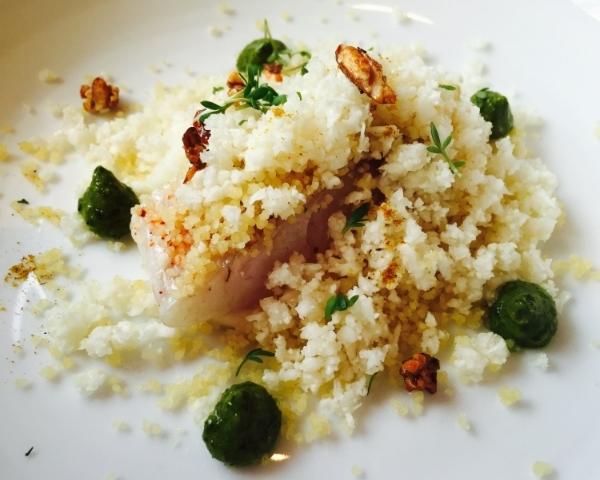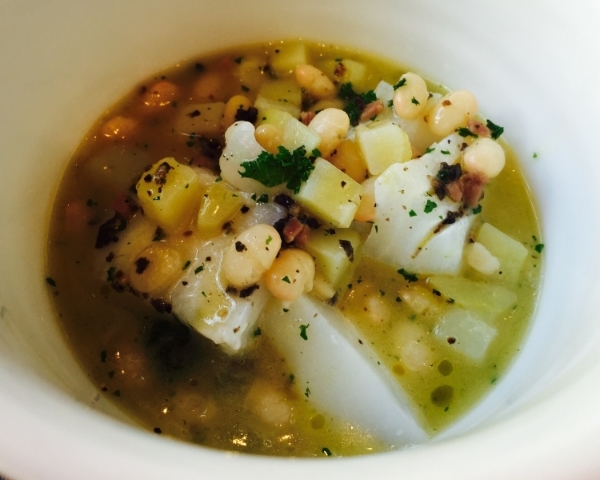Strawberries, raspberry macaroon and mint sorbet
The Perrin family of the winery Château de Beaucastel in Châteauneuf-du-Pape – led by brothers Jean-Pierre and François and their seven offspring – has over the past 30 years created a very specific and appealing, contemporary style that has become an environmental model in organic wine making, and a leading global brand. Their portfolio is impressive, whether it be an august old-vine red, such as their rare Hommage à Jacques Perrin, their more simple daily-drinking red Côtes-du-Rhône, or their spectacular wine boutique in the Provençal village of Gigondas (population 585). Included in this incredible package is their welcoming restaurant L’Oustalet in the center of town, where an interior decor seamlessly blends ancient and modern. The outdoor tables spread out onto a stone terrace overlooking the renovated square, which is peppered with ancient sycamore trees – a spot that was once a parking lot and is now a sybaritic space filled with picnic tables and a spot for sitting, strolling, reflecting.
I wouldn’t even want to try to guess the number of meals I have savored in this setting over the past 35 years, the best of which were relished at the hands of the Perrin family and their slim, self-effacing, and super-talented chef Laurent Deconinck. Here, like most everything the Perrins do, nothing is overwrought, or laid on with a heavy hand. There is thought to the balance, energy, look and feel of both the interior design and the food itself.
Laurent’s summer bouillabaisse, which I wholly appreciated this week, is like a modern love poem to this Provençal fish soup classic, a dish that is often too hackneyed, boring, overcooked, even in the most famous establishments. Laurent’s soup – a mix of fish and shellfish that includes lobster tail from Corsica, and a medley of rockfish stars of the sea: monkfish, John Dory, and rascasse or scorpion fish – is a modern masterpiece. The fish all look and taste as though they just leapt from the sea, bathed in a thick broth, enlivened by dollops of velvety, spicy aioli or garlic mayonnaise. Thick strips of crouton-like toast come along, for dipping in the bright-flavored broth or for slathering with the aioli.
The genius in Laurent’s food is in its balance and freshness so that, despite having had a multi-course, two-hour feast, you walk away with a forceful pep in your step. His recent dessert creation is a case in point: strawberries at their peak of ripeness are topped with a single half of a raspberry macaroon, teamed up with a brilliant green mint sorbet, flanked by cubes of fresh berries and paper-thin strips of mint (photo).
The all-male staff at L’Oustalet is at once forwardly familiar and professional to a fault. You feel they are having a great time at work, and why shouldn’t they, with all the great seasonal ingredients of Provence, the sun shining, and a wine cellar that would make almost anyone weep? I won’t even begin to tick off the great wines one finds here, but suffice it to say that if you have a favored wine from the northern or southern Rhône, you’ll find it here, at such great value prices you’ll squint and look twice. My latest discovery is the Châteauneuf Clos St Pierre, an ancient Châteauneuf-du-Pape vineyard taken over in 2009 by Carole and Pierre Perveyrie. Their tannic cuvé Urbi, with 40% Grenache, 40% Syrah, and 20% Mourvèdre, is truly appealing and pleasing, especially for those who love a bit of leathery, animal sensation that so many southern Rhône wines can produce.
Wine lovers should not miss a visit to their wine shop just up the street from the restaurant. There are also three modern hotel rooms above the shop, if you’d rather not walk too far “home” after lunch or dinner.
L’Oustalet | Place du Village | 84190 Gigondas | Tel: +33 4 90 65 85 30 | Closed Sunday and Monday | Menus from 35 to 56€ | Wine tasting menus from 89 to 136€ | www.loustalet-gigondas.com | contact@loustalet-gigondas.com










